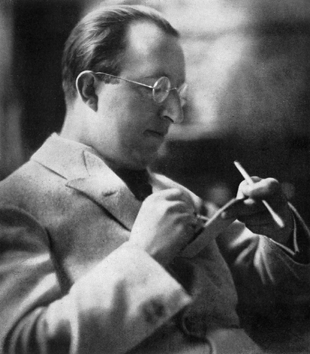Erich Mendelsohn
 Erich Mendelsohn |
|
Erich Mendelsohn was born March 21st, 1887, in Allstein (now Olsztyn in Poland).
He got his education at the University of Munich and the Technical School (Technischen Hochschule) of Berlin. To finance these studies he worked as a decorator and illustrator. He had friends among Berlin’s avant-garde art movements such as the Blaue Reiter, Dada and dancers like Clothilde van Derp and Sacharov.
In 1912, he opened his own bureau of architecture in Munich. Two years later, he moved to Berlin and married Luise Maas.
During his Berlin time, the Expressionist movement influenced him. These influences he translated into his early designs, most notably the Einsteinturm (1920-24), an observatory he built in Potsdam for the Astrophysical Institute. Actually, the Einsteinturm is considered by some to be a milestone of Expressionist architecture: ‘ Der Einsteinturm ist die höchste Verwirklichung der architektonischen Expressionismus’ (Posener, in Schaubühne am Lehniner Platz, 1981, 8). However, Mendelsohn didn’t start building until after the First World War. He made a lot of architectural drawings when he served in the trenches at both the Russian and the French frontlines. Back from the war, in 1919, he opened his own architect’s firm in Berlin. A few years later, he built the Einsteinturm and designed many houses, shops and firms. His first urban complex to be executed was the WOGA in Berlin, at the upper Kurfürstendamm, in 1927-28. Part of this complex was the movie theatre ‘Universum’ that half a century later would become the innovative multifunctional theatre of the Schaubühne am Lehniner Platz.
Mendelsohn moved to the Netherlands in 1933 and worked a lot in London and Palestina until the outbreak of the Second World War. Some of his more elaborate designs of this period include two hospitals built in the years 1936-37, the Government Hospital in Haifa and the Hadassah Hospital in Jerusalem.
In 1941, Mendelsohn left Europe for the United States. He lectured at universities, worked as an advisor for the United States war department, and was appointed lecturer of architecture at the University of California. He kept on working as an architect and designed, among others, several synagogues, in St. Louis, Ohio, Michigan and Minnesota.
Mendelsohn died of cancer, in San Fransisco on November 15th, 1953.
It is hard to define his architecture and many volumes are written to do justice to the variety of works designed by Mendelsohn. As far as the Universum-building is concerned, the WOGA complex shows that Mendelsohn was a functionalist architect with a broader, idealist vision on architecture. Architecture, in this vision, greatly influenced the surroundings of men, their way of life and their relationships. The idea behind the WOGA-design had to do with a concern for general wellbeing. In a way - Mendelsohn said this himself in a letter on the Dutch schools of architecture - Mendelsohn’s designs were a combination of both strict functionalism (the Rotterdam school) and expressionism (Amsterdam School). Functionalism has to do with rationality; buildings strictly designed for their use, shaped on the basis of geometrical forms and exploring the possibilities of the new materials of the epoch, such as steel and reinforced concrete. Expressionism favoured organic forms, and closely considered the feel of the building, proportional harmony and the question of how the building relates to its surroundings.
The synthesis of these two architectural schools, Mendelsohn called functional dynamics. Looking at the Universum, this concept becomes comprehensive: it is sober, very functionalist in that it is designed for its use and features no surplus additions or decorations. At the same time, it is dynamic, a living building, not boring to look at (although on the subject of the aesthetic value of most modernist architecture the opinions vary greatly). Posener sensibly described the internal dynamics of Mendelsohn’s architecture: ‘ Mendelsohns Gebäude sind in der Ruhe bewegt und leben von einer Spannung, die eben darum, wesentlich wird, weil sie sich urban vorträgt’: Mendelsohn’s buildings are alive in their stillness and their urban character evokes an essential tension (Schaubühne am Lehniner Platz, 1981, 12).